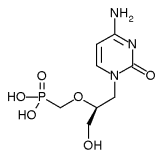By cloaking an antiviral drug in a fat molecule, scientists have developed a new compound that people might someday swallow to ward off smallpox.
A vaccine against smallpox exists, but governments' supplies have dwindled since the disease was declared eradicated in 1980. Smallpox virus is preserved in laboratories in the United States and Russia, however, and some smallpox stocks may have fallen into terrorist hands when the Soviet Union fell.
In response to smallpox's potential as a bioterror threat, the U.S. government in the 1990s started sponsoring research into drugs that inhibit poxviruses. The star candidate so far has been cidofovir, which kills the smallpox virus in test tube studies. Cidofovir, however, has two major drawbacks. The drug, marketed as Vistide for cytomegalovirus eye infections, must be injected intravenously. Also, the large doses required to get cidofovir into cells can damage the kidneys, says Karl Y. Hostetler, an endocrinologist at the Veterans Affairs San Diego Healthcare System and the University of California, San Diego in La Jolla.
To create an oral version of cidofovir that's less toxic, Hostetler and his colleagues packaged each molecule in a partially degraded, digestible fat molecule. The new compound, called hexadecyloxypropyl-cidofovir (HDPCDV), is absorbed intact through the membranes of mammalian cells--including those infected with a poxvirus--the researchers reported this week in Prague, Czech Republic, at the 15th International Conference on Antiviral Research. Inside the cells, enzymes strip away HDP-CDV's fatty portion, then its cidofovir binds to poxvirus and prevents it from replicating, Hostetler says. HDP-CDV is more than 100 times as effective against poxviruses as cidofovir is.
Further tests on mice receiving HDP-CDV orally once or twice a day over 5 days show that the animals fended off cowpox, a dose relative of smallpox, reports John W. Huggins, a virologist at the U.S. Army Medical Research Institute of Infectious Diseases in Fort Detrick, Md.
Cowpox and smallpox spread by direct contact or via an infected host's saliva droplets that are inhaled by others. The cowpox and smallpox viruses cause skin lesions and life-threatening damage in the digestive tract and lungs. Huggins' team exposed several groups of mice to an aerosol of cowpox virus and simultaneously gave some the HDP-CDV treatment or cidofovir. Others were untreated.
Samples of lung tissue from the untreated mice contained heavy viral loads, whereas tissue from mice given HDP-CDV had nearly undetectable cowpox virus. Mice getting cidofovir had significantly more viruses in their lungs than the HDP-CDV mice did.
The researchers plan next to test HDP-CDV in monkeys infected with monkeypox, which resembles smallpox, Huggins says.
"I don't want to be overly optimistic," Hostetler says, "but it's intriguing that after thousands of years of death from smallpox, there is something that ... might treat the disease."
Huggins says that a treatment is needed to protect people against a possible smallpox-virus release. Not enough vaccine has been stockpiled to inoculate everyone, and any person who is pregnant, has cancer, or has a weakened immune system shouldn't get the vaccine.
"This [study] is very promising but very preliminary," says Catherine Laughlin, a virologist at the National Institute of Allergy and Infectious Diseases in Bethesda, Md. "Since cidofovir has two serious drawbacks, we would really prefer to have a better drug."
In addition to HDP-CDV, as many as 27 other drugs show promise against poxviruses in early lab tests, says virologist Earl R. Kern of the University of Alabama--Birmingham School of Medicine.
Based on lab tests, Kern says, cidofovir and HDP-CDV may also prove useful against chickenpox, herpes, and infectious mononucleosis.
COPYRIGHT 2002 Science Service, Inc.
COPYRIGHT 2002 Gale Group



